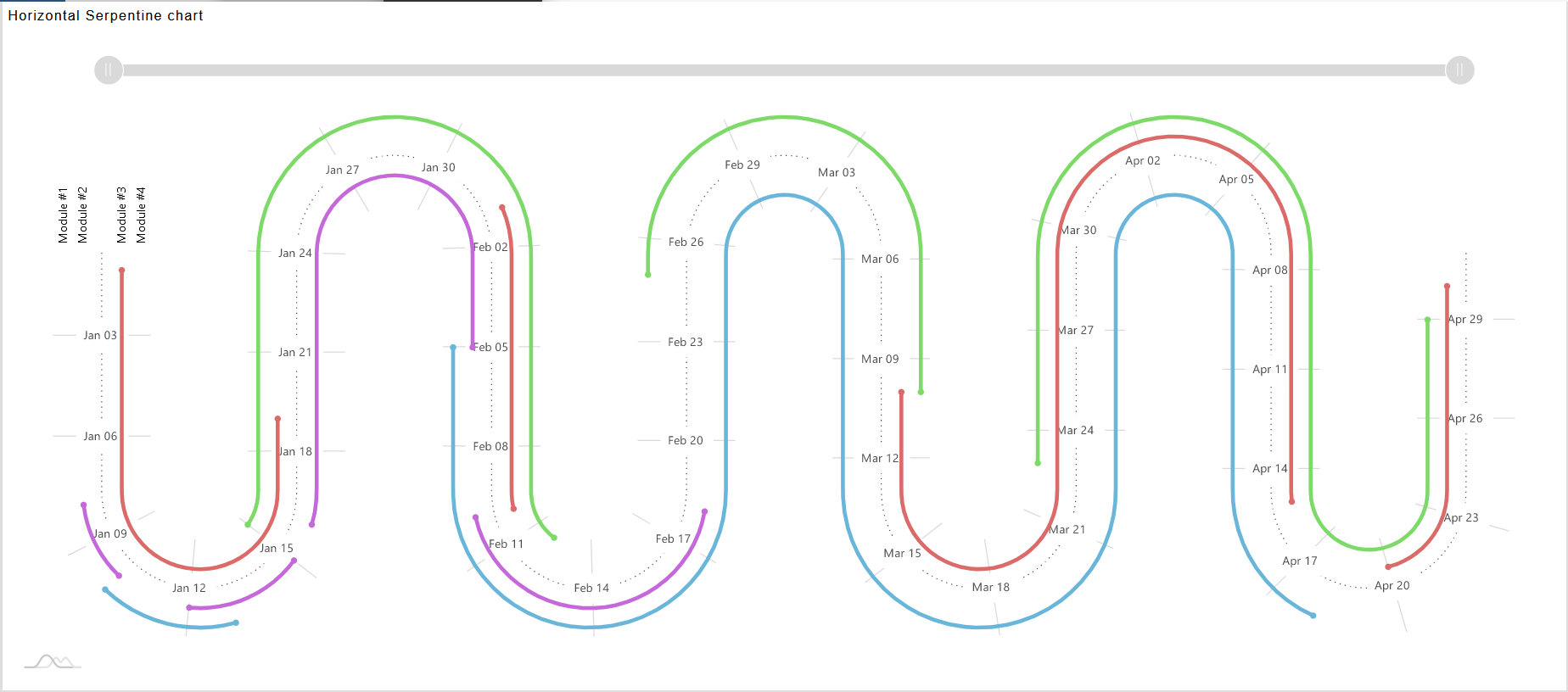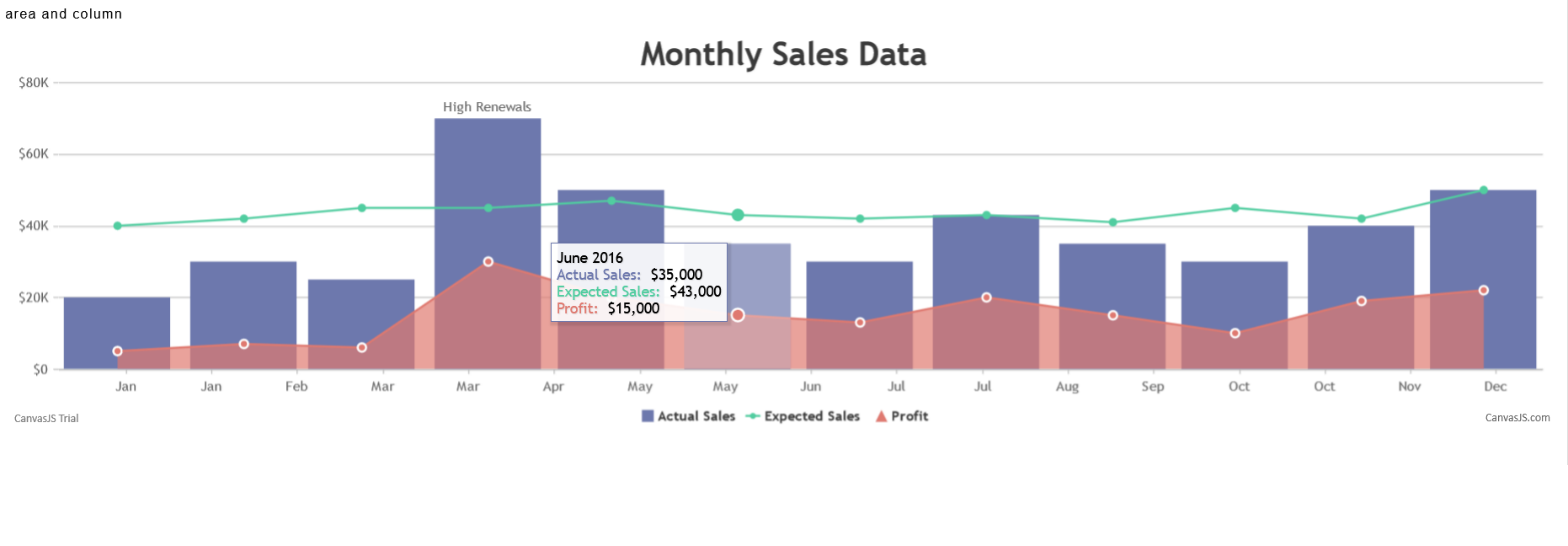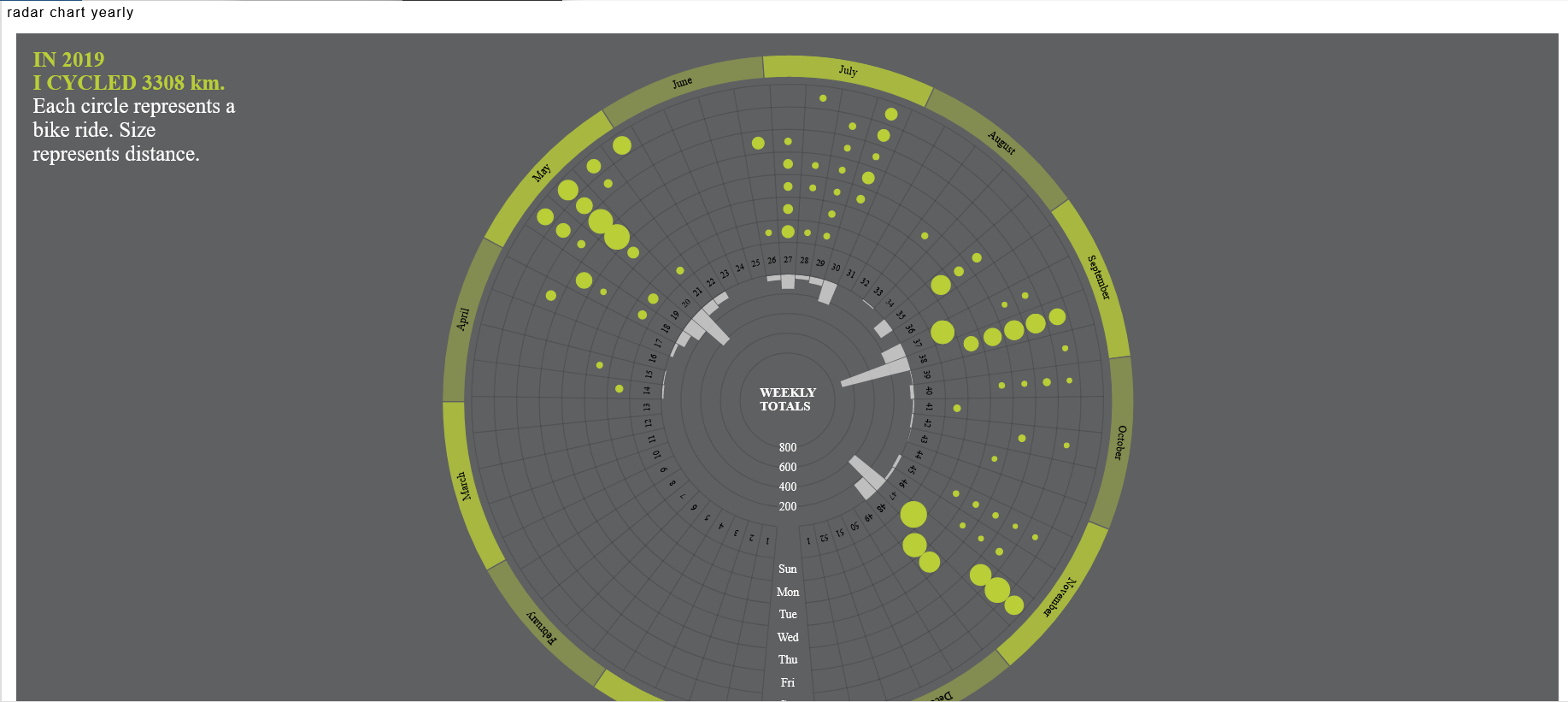Custom Visualization Widget
Custom Visualization: This video contains how to create custom visualization in AIV.
Only users with Dashboard privilege have access to this section!
Some of the example of Custom Visualization
Custom visualization provides the function to add custom code into AIV. by using this users can make required visualizations like charts, maps, tables, user interface for the dashboard, custom filters, etc.
Here, we have example to user required charts, you can click on each of the chart and access the code of chart widget.
Example 1:

To create the above example put the code in relevant tabs:
HTML
JavaScript
/**
- This demo was created using amCharts 4.
- For more information visit:
- https://www.amcharts.com/
- Documentation is available at:
- https://www.amcharts.com/docs/v4/
*/
// Themes begin am4core.useTheme(am4themes_animated); // Themes end
var chart = am4core.create("chartdiv", am4plugins_timeline.SerpentineChart); chart.curveContainer.padding(20,20,20,20); chart.levelCount = 8; chart.orientation = "horizontal"; chart.fontSize = 11;
var colorSet = new am4core.ColorSet(); colorSet.saturation = 0.6;
chart.data = [ { "category": "Module #1", "start": "2016-01-10", "end": "2016-01-13", "color": colorSet.getIndex(0), "task": "Gathering requirements" }, { "category": "Module #1", "start": "2016-02-05", "end": "2016-04-18", "color": colorSet.getIndex(0), "task": "Development" }, { "category": "Module #2", "start": "2016-01-08", "end": "2016-01-10", "color": colorSet.getIndex(5), "task": "Gathering requirements" }, { "category": "Module #2", "start": "2016-01-12", "end": "2016-01-15", "color": colorSet.getIndex(5), "task": "Producing specifications" }, { "category": "Module #2", "start": "2016-01-16", "end": "2016-02-05", "color": colorSet.getIndex(5), "task": "Development" }, { "category": "Module #2", "start": "2016-02-10", "end": "2016-02-18", "color": colorSet.getIndex(5), "task": "Testing and QA" }, { "category": "", "task": "" },{ "category": "Module #3", "start": "2016-01-01", "end": "2016-01-19", "color": colorSet.getIndex(9), "task": "Gathering requirements" }, { "category": "Module #3", "start": "2016-02-01", "end": "2016-02-10", "color": colorSet.getIndex(9), "task": "Producing specifications" }, { "category": "Module #3", "start": "2016-03-10", "end": "2016-04-15", "color": colorSet.getIndex(9), "task": "Development" }, { "category": "Module #3", "start": "2016-04-20", "end": "2016-04-30", "color": colorSet.getIndex(9), "task": "Testing and QA" }, { "category": "Module #4", "start": "2016-01-15", "end": "2016-02-12", "color": colorSet.getIndex(15), "task": "Gathering requirements" },{ "category": "Module #4", "start": "2016-02-25", "end": "2016-03-10", "color": colorSet.getIndex(15), "task": "Development" }, { "category": "Module #4", "start": "2016-03-23", "end": "2016-04-29", "color": colorSet.getIndex(15), "task": "Testing and QA" } ];
chart.dateFormatter.dateFormat = "yyyy-MM-dd"; chart.dateFormatter.inputDateFormat = "yyyy-MM-dd";
var categoryAxis = chart.yAxes.push(new am4charts.CategoryAxis()); categoryAxis.dataFields.category = "category"; categoryAxis.renderer.grid.template.disabled = true; categoryAxis.renderer.labels.template.paddingRight = 25; categoryAxis.renderer.minGridDistance = 10; categoryAxis.renderer.innerRadius = -60; categoryAxis.renderer.radius = 60;
var dateAxis = chart.xAxes.push(new am4charts.DateAxis()); dateAxis.renderer.minGridDistance = 70; dateAxis.baseInterval = { count: 1, timeUnit: "day" };
dateAxis.renderer.tooltipLocation = 0; dateAxis.startLocation = -0.5; dateAxis.renderer.line.strokeDasharray = "1,4"; dateAxis.renderer.line.strokeOpacity = 0.7; dateAxis.tooltip.background.fillOpacity = 0.2; dateAxis.tooltip.background.cornerRadius = 5; dateAxis.tooltip.label.fill = new am4core.InterfaceColorSet().getFor("alternativeBackground"); dateAxis.tooltip.label.paddingTop = 7;
var labelTemplate = dateAxis.renderer.labels.template; labelTemplate.verticalCenter = "middle"; labelTemplate.fillOpacity = 0.7; labelTemplate.background.fill = new am4core.InterfaceColorSet().getFor("background"); labelTemplate.background.fillOpacity = 1; labelTemplate.padding(7,7,7,7);
var categoryAxisLabelTemplate = categoryAxis.renderer.labels.template; categoryAxisLabelTemplate.horizontalCenter = "left"; categoryAxisLabelTemplate.adapter.add("rotation", function (rotation, target) { var position = dateAxis.valueToPosition(dateAxis.min); return dateAxis.renderer.positionToAngle(position) + 90; })
var series1 = chart.series.push(new am4plugins_timeline.CurveColumnSeries()); series1.columns.template.height = am4core.percent(20); series1.columns.template.tooltipText = "{task}: [bold]{openDateX}[/] - [bold]{dateX}[/]";
series1.dataFields.openDateX = "start"; series1.dataFields.dateX = "end"; series1.dataFields.categoryY = "category"; series1.columns.template.propertyFields.fill = "color"; // get color from data series1.columns.template.propertyFields.stroke = "color"; series1.columns.template.strokeOpacity = 0;
var bullet = new am4charts.CircleBullet(); series1.bullets.push(bullet); bullet.circle.radius = 3; bullet.circle.strokeOpacity = 0; bullet.propertyFields.fill = "color"; bullet.locationX = 0;
var bullet2 = new am4charts.CircleBullet(); series1.bullets.push(bullet2); bullet2.circle.radius = 3; bullet2.circle.strokeOpacity = 0; bullet2.propertyFields.fill = "color"; bullet2.locationX = 1;
chart.scrollbarX = new am4core.Scrollbar(); chart.scrollbarX.align = "center" chart.scrollbarX.width = am4core.percent(90);
var cursor = new am4plugins_timeline.CurveCursor(); chart.cursor = cursor; cursor.xAxis = dateAxis; cursor.yAxis = categoryAxis; cursor.lineY.disabled = true; cursor.lineX.strokeDasharray = "1,4"; cursor.lineX.strokeOpacity = 1;
dateAxis.renderer.tooltipLocation2 = 0; categoryAxis.cursorTooltipEnabled = false;
CSS
body { font-family: -apple-system, BlinkMacSystemFont, "Segoe UI", Roboto, Helvetica, Arial, sans-serif, "Apple Color Emoji", "Segoe UI Emoji", "Segoe UI Symbol"; }
#chartdiv { width: 100%; height: 600px; } .demo-theme-dark .demo-background { background: #000; }
Example 2:

To create the above example put the code in relevant tabs:
HTML
<!DOCTYPE HTML>
<html>
<head>
<script>
</script>
</head>
<body>
<div id="chartContainer" style="height: 370px; width: 100%;"></div>
<script src="https://canvasjs.com/assets/script/canvasjs.min.js"></script>
</body>
</html>
JavaScript
window.onload = function () {
var chart = new CanvasJS.Chart("chartContainer", {
animationEnabled: true,
theme: "light2",
title: {
text: "Monthly Sales Data"
},
axisX: {
valueFormatString: "MMM"
},
axisY: {
prefix: "$",
labelFormatter: addSymbols
},
toolTip: {
shared: true
},
legend: {
cursor: "pointer",
itemclick: toggleDataSeries
},
data: [
{
type: "column",
name: "Actual Sales",
showInLegend: true,
xValueFormatString: "MMMM YYYY",
yValueFormatString: "$#,##0",
dataPoints: [
{ x: new Date(2016, 0), y: 20000 },
{ x: new Date(2016, 1), y: 30000 },
{ x: new Date(2016, 2), y: 25000 },
{ x: new Date(2016, 3), y: 70000, indexLabel: "High Renewals" },
{ x: new Date(2016, 4), y: 50000 },
{ x: new Date(2016, 5), y: 35000 },
{ x: new Date(2016, 6), y: 30000 },
{ x: new Date(2016, 7), y: 43000 },
{ x: new Date(2016, 8), y: 35000 },
{ x: new Date(2016, 9), y: 30000},
{ x: new Date(2016, 10), y: 40000 },
{ x: new Date(2016, 11), y: 50000 }
]
},
{
type: "line",
name: "Expected Sales",
showInLegend: true,
yValueFormatString: "$#,##0",
dataPoints: [
{ x: new Date(2016, 0), y: 40000 },
{ x: new Date(2016, 1), y: 42000 },
{ x: new Date(2016, 2), y: 45000 },
{ x: new Date(2016, 3), y: 45000 },
{ x: new Date(2016, 4), y: 47000 },
{ x: new Date(2016, 5), y: 43000 },
{ x: new Date(2016, 6), y: 42000 },
{ x: new Date(2016, 7), y: 43000 },
{ x: new Date(2016, 8), y: 41000 },
{ x: new Date(2016, 9), y: 45000 },
{ x: new Date(2016, 10), y: 42000 },
{ x: new Date(2016, 11), y: 50000 }
]
},
{
type: "area",
name: "Profit",
markerBorderColor: "white",
markerBorderThickness: 2,
showInLegend: true,
yValueFormatString: "$#,##0",
dataPoints: [ { x: new Date(2016, 0), y: 5000 }, { x: new Date(2016, 1), y: 7000 }, { x: new Date(2016, 2), y: 6000 }, { x: new Date(2016, 3), y: 30000 }, { x: new Date(2016, 4), y: 20000 }, { x: new Date(2016, 5), y: 15000 }, { x: new Date(2016, 6), y: 13000 }, { x: new Date(2016, 7), y: 20000 }, { x: new Date(2016, 8), y: 15000 }, { x: new Date(2016, 9), y: 10000}, { x: new Date(2016, 10), y: 19000 }, { x: new Date(2016, 11), y: 22000 } ] }] }); chart.render();
function addSymbols(e) { var suffixes = ["", "K", "M", "B"]; var order = Math.max(Math.floor(Math.log(e.value) / Math.log(1000)), 0);
if(order > suffixes.length - 1)
order = suffixes.length - 1;
var suffix = suffixes[order];
return CanvasJS.formatNumber(e.value / Math.pow(1000, order)) + suffix;
}
function toggleDataSeries(e) {
if (typeof (e.dataSeries.visible) === "undefined" || e.dataSeries.visible) {
e.dataSeries.visible = false;
} else {
e.dataSeries.visible = true;
}
e.chart.render();
}
}
CSS
Example 3:

To create the above example put the code in relevant tabs:
HTML
JavaScript
CSS
Example 4:

To create the above example put the code in relevant tabs: